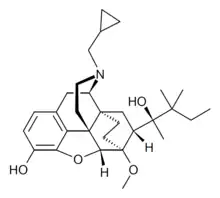BU08028
 | |
| Identifiers | |
|---|---|
IUPAC name
| |
| CAS Number | |
| PubChem CID | |
| ChemSpider | |
| Chemical and physical data | |
| Formula | C30H43NO4 |
| Molar mass | 481.677 g·mol−1 |
| 3D model (JSmol) | |
SMILES
| |
InChI
| |
BU08028 is a drug which acts as a potent partial agonist at both the μ-opioid receptor and nociceptin receptor. It is a homologue of buprenorphine extended by just one carbon on the side chain, but has relatively greater activity at the nociceptin receptor, which is thought to reduce the abuse potential without compromising analgesia.[1][2][3][4]
See also
References
- ↑ Cami-Kobeci G, Polgar WE, Khroyan TV, Toll L, Husbands SM (October 2011). "Structural determinants of opioid and NOP receptor activity in derivatives of buprenorphine". Journal of Medicinal Chemistry. 54 (19): 6531–7. doi:10.1021/jm2003238. PMC 3188691. PMID 21866885.
- ↑ Khroyan TV, Polgar WE, Cami-Kobeci G, Husbands SM, Zaveri NT, Toll L (March 2011). "The first universal opioid ligand, (2S)-2-[(5R,6R,7R,14S)-N-cyclopropylmethyl-4,5-epoxy-6,14-ethano-3-hydroxy-6-methoxymorphinan-7-yl]-3,3-dimethylpentan-2-ol (BU08028): characterization of the in vitro profile and in vivo behavioral effects in mouse models of acute pain and cocaine-induced reward". The Journal of Pharmacology and Experimental Therapeutics. 336 (3): 952–61. doi:10.1124/jpet.110.175620. PMC 3061529. PMID 21177476.
- ↑ Ding H, Czoty PW, Kiguchi N, Cami-Kobeci G, Sukhtankar DD, Nader MA, et al. (September 2016). "A novel orvinol analog, BU08028, as a safe opioid analgesic without abuse liability in primates". Proceedings of the National Academy of Sciences of the United States of America. 113 (37): E5511-8. doi:10.1073/pnas.1605295113. PMC 5027459. PMID 27573832.
- ↑ Kiguchi N, Ding H, Ko MC (April 2020). "Therapeutic potentials of NOP and MOP receptor coactivation for the treatment of pain and opioid abuse". Journal of Neuroscience Research. doi:10.1002/jnr.24624. PMC 7573817. PMID 32255240.
This article is issued from Offline. The text is licensed under Creative Commons - Attribution - Sharealike. Additional terms may apply for the media files.